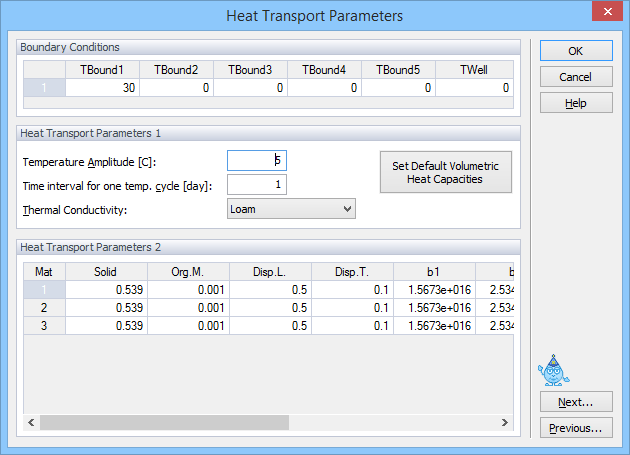Information needed for defining heat transport problem is entered in the Heat Transport dialog window. In this window users specify Heat Transport Parameters and temperatures for the Boundary Conditions.

The following Heat Transport Parameters (bottom part of the dialog window) are specified for each soil material:
Solid |
Volume fraction of solid phase, θn [-] |
Org.M. |
Volume fraction of organic matter, θo [-] |
Disp.L. |
Longitudinal thermal dispersivity, λL [L] |
Disp.T. |
Longitudinal thermal dispersivity, λT [L] |
b1 |
Coefficient b1 in the expression for the thermal conductivity function [W/L/K] |
b2 |
Coefficient b2 in the expression for the thermal conductivity function [W/L/K] |
b3 |
Coefficient b3 in the expression for the thermal conductivity function [W/L/K] |
Cn |
Volumetric heat capacity of the solid phase, Cn [J/L3/K] |
Co |
Volumetric heat capacity of organic matter, Co [J/L3/K] |
Cw |
Volumetric heat capacity of the liquid phase, Cw [J/L3/K] |
Boundary Conditions:
Temperatures for Boundary Conditions with time-independent boundary conditions are also specified in this dialog window.
TBound1 Value of the temperature for the first time-independent boundary condition [K]. Set equal to zero if no time-independent boundary condition is specified. The same for TBound2 through TBound4
TWell Value of the temperature for the sixth time-independent boundary condition [K]. If internal sources are specified, then TWell is automatically used for the temperature of water injected into the flow region from sources in the transport domain. Set equal to zero if no sixth time-independent boundary condition and no internal sources are specified.
The boundary condition at the soil surface may be approximated using a sinus wave with the maximum one hour after noon and the minimum one hour after midnight as follows:
![]()
where T0 is the average temperature at the soil surface [K], A is the Temperature Amplitude at the soil surface [K], and p is the Time Interval for completion of one sine wave temperature (usually 1 day, the default value). The second part of the sine term is included to set the maximum temperature at 1 p.m.
Default values for the parameters in the Thermal Conductivities of three textural classes (sand, loam and clay) are provided by HYDRUS [Chung and Horton, 1987]. Default volumetric heat capacities for the solid phase, organic matter, and liquid phase are also given (Set Default Volumetric Heat Capacities).
When the parameter estimation option is selected, then users must provide initial estimates of the optimized heat transport parameters, specify which parameters are to be optimized (check appropriate checkboxes), and provide parameter constraints for the optimization. Zero values for the minimum and maximum values signify that parameters are unconstrained. The Heat Transport Parameters dialog window for the inverse problem is not further shown here.
Notice that thermal conductivity and volumetric heat capacity parameters have units of [Wm-1K-1] and [Jm-3 K-1], respectively. These units, when converted to basic SI units are [ML-1T-2K-1] and [MLT-3K-1], respectively, and thus contain time to the negative second or third power, which needs to be taken into account during any time conversion.
Although the apparent (derived) units for the thermal conductivity and the thermal capacity are (W/m/K) and (J/m3/K), respectively, the basic SI units (i.e., in mass, length, and time) are [ML/T3/K] and [M/L/T2/K], respectively. Thus when converting the thermal conductivity or the thermal capacity to new time units, one needs to make conversions directly in the basic SI units, and to convert time to the third or second power, respectively. The same is true for the length units. Note that when one converts the HYDRUS project to meters and seconds, one will get the familiar values of the thermal capacity and thermal conductivity.